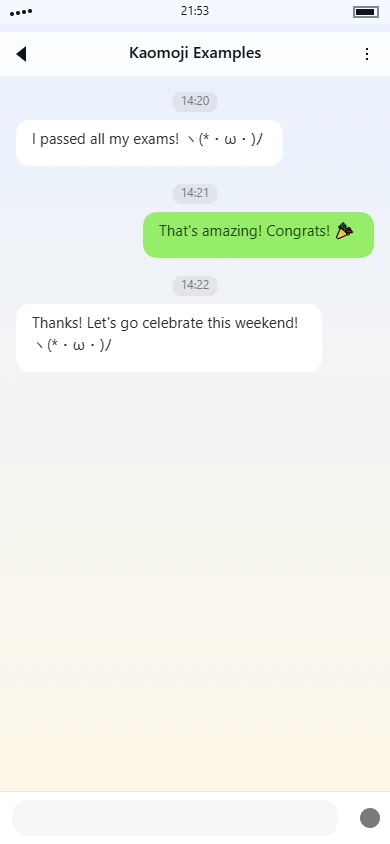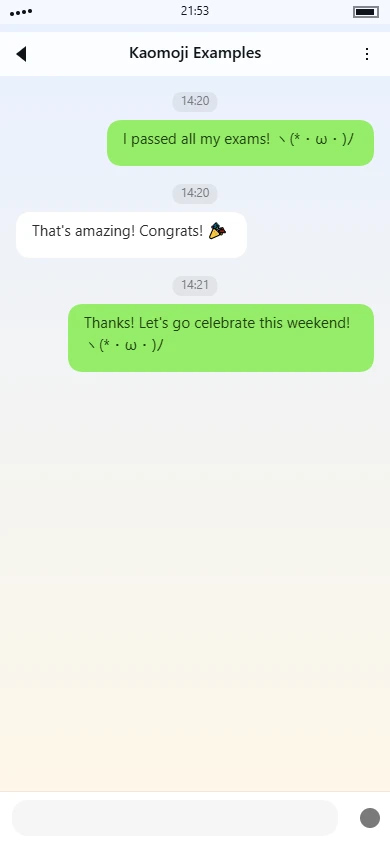(¯▿¯) kaomoji meaning | usage tips

Overview
The kaomoji
(¯▿¯)¯▿Symbol Breakdown
- Parentheses
(
: These curved brackets form the outer boundary of the face, establishing a rounded shape that suggests a complete facial structure rather than just floating features) - Macrons
: The horizontal lines above the triangle function as simplified eyes, positioned at equal height to create a balanced, symmetrical appearance¯ - Upward triangle
: This geometric symbol serves as the mouth element, with its upward orientation suggesting a small, contained smile rather than an exaggerated expression▿ - Spatial arrangement: The elements are closely positioned without additional spacing, creating a compact facial representation where all components are clearly visible within the parentheses
Emotion & Aesthetic Analysis
The expression conveyed by
(¯▿¯)The geometric precision of the triangle mouth combined with the simple horizontal eye lines creates a somewhat technical or calculated appearance. This gives the expression a quality that could be interpreted as smugness or quiet confidence rather than pure happiness. The symmetrical arrangement and clean lines contribute to a balanced, composed aesthetic that works well in digital communication where subtle emotional nuance is needed.
In practical usage, this kaomoji often appears in contexts where someone is expressing quiet satisfaction with an outcome, mild amusement at a situation, or a sense of self-assurance without needing to boast. It can serve as a response to successfully completing a task, understanding a complex concept, or observing something that confirms one's expectations. The expression maintains a degree of restraint that makes it suitable for professional or semi-formal digital communication where more exaggerated emoticons might seem inappropriate.
Compared to similar kaomoji,
(¯▿¯)(´・ω・conveys more vulnerability andTag categories
Use tags to quickly understand this kaomoji.
Usage guide
Usage Guide for (¯▿¯)
The kaomoji (¯▿¯) is a versatile and charming emoticon that captures a blend of quiet contentment, gentle amusement, and playful self-satisfaction. It's characterized by its small, triangular mouth (▿) nestled under a straight or slightly curved top line (¯), creating an expression that is subtly happy, a little smug, or calmly pleased. This emoticon is perfect for informal digital communication where you want to convey a positive but understated emotion—think of it as a soft smile or a quiet chuckle translated into text. It often appears in casual chats, social media comments, and gaming communities to express everything from mild triumph to cozy contentment, without the intensity of more exaggerated emoticons. Its charm lies in its ambiguity; it can be read as cute, slightly mischievous, or simply relaxed, making it a flexible tool for adding warmth and personality to your messages.
Use Cases
- Sharing a small personal win, like finally finishing a household chore you've been putting off.
- Reacting to a friend's silly joke or lighthearted story in a group chat.
- Commenting on a social media post where someone shares a simple, happy moment, like a photo of their pet.
- Expressing quiet confidence after solving a tricky puzzle in a mobile game.
- Responding to a plan that sounds cozy and low-key, like a movie night at home.
- Acknowledging a clever observation in a discussion without sounding overly enthusiastic.
- Adding a touch of cuteness to a message where you're admitting a minor mistake or oversight.
- Reacting to a meme or funny video that made you smirk rather than laugh out loud.
- Signaling mild amusement in a work-friendly chat (e.g., with close colleagues) about a non-serious topic.
- Conveying a sense of peaceful satisfaction after a relaxing activity, like reading a book or drinking tea.
- Using in gaming chats to show you're content with your current progress or loot.
- Replying to a compliment in a humble, playful way to avoid sounding boastful.
Examples
-
Friend: "I just managed to cook dinner without burning anything for once!"
You: "Look at you, master chef (¯▿¯)" -
Colleague (in a casual Slack channel): "The boss approved our team lunch idea—we're getting pizza!"
You: "Nice, my stomach is already thanking you (¯▿¯)" -
Family group chat: "Who left the last cookie in the jar? It made my day."
You: "That was me, glad it helped (¯▿¯)" -
Online gaming buddy: "I found a rare item in that dungeon we cleared earlier."
You: "Lucky you! I'm just chilling here with my common loot (¯▿¯)" -
Social media comment on a friend's vacation photo: "Looks so peaceful there!"
You: "Wish I could teleport into this pic (¯▿¯)" -
Response to a funny meme in a Discord server: "This is too relatable haha."
You: "Right? My life in a nutshell (¯▿¯)"
Notes
- Avoid using (¯▿¯) in formal or high-stakes contexts, such as professional emails, official reports, or serious discussions (e.g., apologies or conflicts), as its playful tone might come off as insincere or unprofessional.
- Be mindful that the emoticon's subtlety could be misinterpreted—for instance, in cultures or platforms where more explicit emojis are the norm, it might be seen as vague or overly casual. On sites like Twitter or Reddit, it blends well in casual threads, but in very brief or anonymous interactions, it may not convey enough emotion.
- While (¯▿¯) is generally friendly, overusing it in a single conversation could dilute its impact or make you seem disengaged; reserve it for moments where a light, positive touch is appropriate.
Usage examples
Real conversation samples that feature this kaomoji.

Example 1

Example 2
Related kaomoji
You might also enjoy these kaomoji.